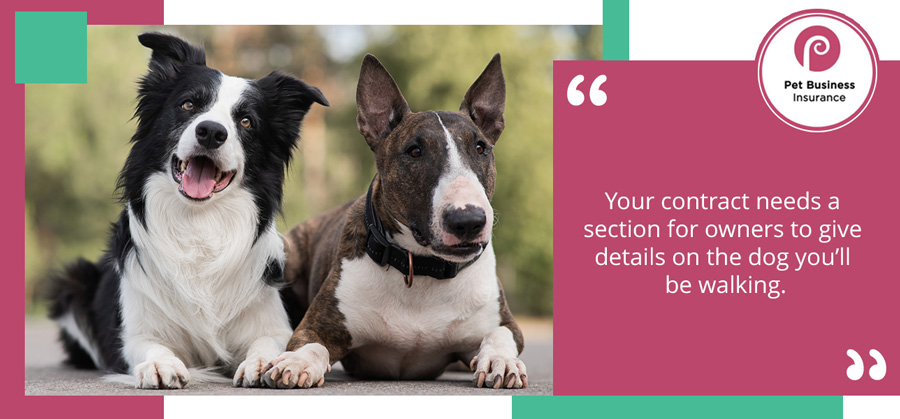
Dog walking as a career means lots of fresh air, exercise, doggie kisses, and a bit more paperwork than you may expect.
You might be wondering, should a dog walker have a contract? One of the most important bits of paperwork is your dog walking contract.
But what do you need to include, and how do you write one? If the thought of writing a contract gives you chills, don’t panic; you don’t need to write it in legal terms, in fact, it’s a lot better if you don’t.
Your contract needs to be clear, understandable, and reasonable to both you and your customers. Plain English means less room for misunderstandings, so you can put away your dictionary.
Top Tip: Have a professional review legal documents.
Start with your service agreement
The main portion of your dog walking contract will describe the services that you will provide for each dog walking client. Whether this be a run, hike, a 30-minute walk or playing at the dog park – these details should be outlined to clearly define what the customer can expect from your dog walking business.
Some standard policies include additional details around payment, late fees, cancellation fees, dog walking insurance policies and responsibilities, and business policies regarding emergencies, damages or medical expenses.
Top tip: Set up your contract as a template and email yourself a copy. Even if you have a computer malfunction, you’ll be able to get your contract as long as you can access your emails. Make sure you send yourself a new copy every time you update it.
List all your services, add-ons, and rates
A lot of dog walkers also offer additional services like day care, feeding and grooming. If you offer any perks, you should list these as well as any limitations and rates.
Be as detailed as possible. If you’re happy to give dogs food and medicine but not clip broken nails, make sure that’s noted. Since dog walkers often pick up dogs from an owner’s home while they’re not around, many will ask that the dog’s food and water is topped up or that they crate or keep the dog within certain areas of the home.
Include a list of rates for different scenarios as well.
- Group walks versus solo walk rates + how many dogs will be walked at the same time
- Include weekend, holiday, and out of hours prices
- Extra play time at a dog park or in your backyard
- Feeding, topping up water, or giving medicine
Top Tip: Your insurance and local area may have restrictions on the number of dogs you can walk together. Always check your policy to make sure that you’re abiding by the rules and to make sure your coverage is valid in case of an incident.
List your billing and due payment details as well as the payment method expected.

Cancellation policies
Make sure you outline your cancellation and late cancellation policy clearly.
Most dog walkers will charge for last minute cancellations because of the impact on their schedules and income. You also need to explain your arrangements for a cancellation from your side, and cover for when you are on holiday or fall ill.
Top tip: Network with other dog walkers in your area. If you have someone reliable to pick up jobs when needed, you can return the favor - and if either of you end up with an overflow of clients, you’ll both know who to call.
Insurance and liabilities
Include what your dog walking insurance covers, and what the client will be liable for in case of any accidents or incidents. Unless you employ somebody, you aren’t legally required to carry employers’ liability insurance, but it’s always good to future proof and know whether your policy covers this or offers it as an add-on option.
Understand what your policy covers. Here’s some potential situations that you’ll need to consider:
- Maybe one of the dogs you walk is a little unruly and runs away, is there coverage for loss?
- What if a dog gets injured on a walk and needs vet care? Will they need immediate care, or will the owner prefer to take the dog to the vet themselves?
- What happens if a dog you’re walking causes an accident or injures someone else or their dog? Do you have protection in the event someone files a legal claim against you?
- If you’re transporting dogs to your preferred walking destination, is your car or van insured?
- Do you have coverage in the event that you lose the dog owner’s house keys or need a locksmith?
Insurers will have a range of services and types of cover to choose from, so have a chat with your broker to find out the full scope and details your policy will cover.
Top tip: Having your type of insurance within a dog walking contract reassures customers that you take your business and your dedication to protecting dogs seriously.

Emergency procedures and other terms and conditions
Have a section that outlines what you will do in case of an emergency. This should cover everything from notifying the emergency contact to getting an injured animal to the vet.
You should also have a section that covers unusual events that prevent you walking the dog, like dangerous weather. Nobody should expect their dog to be walked in a major storm, but when dealing with customers this needs to be laid out clearly.
Top tip: Having separate sections for each of these makes the contract easier to read for both you and your customers, even if each section is only a paragraph long.
Exceptions and negative policies
It’s just as important to outline what you will not do in the contract.
Some walkers won’t take dogs to a park, some are happy to do so. Some prefer to not attend dog parks or give dogs off-lead time. Some will give medication as needed, and others will not. Make sure your exceptions are noted in writing on your contract.
Top tip: If something is a sticking point for you, do not make an exception “just this once.” Your customer will expect it as a matter of course afterwards, and you will end up in an uncomfortable situation.
Dog Walking Forms – Pet Details
Your contract needs a section for owners to give details on the dog you’ll be walking. You’ll want the following information for every dog:
- Dog name, and any other nicknames they respond to
- Breed, color, and any distinctive features
- Whether the dog is chipped and if so, where they are registered
- Emergency contact and vet details
- Any previous injuries or physical limitations
- Vaccinations and whether they’re allowed in public areas such as dog parks
- Characteristics and personality traits i.e. whether they’re friendly or prefer to not socialize with others
- Whether the dog can group walk or need to be walked alone
- Any medical conditions and what medications and dosage are needed for them
- Any triggers or temperament issues
- Any details on training to maintain such as keeping the dog on a short leash, long leash, on your left side or right side.
Top tip: You need a section for each dog, so if you’re walking multiple pooches from the same house, make sure you have all of the information for each animal.
Having a digital version of your dog walking forms can help owners that prefer to work online. Plus, you can usually adapt a dog walking contract to be signed online using e-signature tools.

Social media use
Most dog walkers will post pictures and videos to their social media and website. Dogs attract views, and cute or funny clips are a bonus.
Before you post anything showing a customer’s dog, make sure they are happy for you to do so – especially if you tag yourself in locations – and have a section covering this in the contract.
Some dogs are worth thousands, and by posting and by tagging the dogs you’re with in public you’re opening up an element of risk. It’s likely a very small risk but be aware of it.
Top tip: Make sure your customer has the choice to opt out of this and note it clearly on the contract. Photos might be appreciated on a personal level. Send the owner a text with a picture of their happy doggo out and about. This is a great value add to clients who can’t spend as much time with their pets and helps reassure them that your business is worth it!
Destination walks
If you live in an area with multiple dog-friendly destinations, these should be noted. It gives the customer options and presenting them can add a bespoke, tailored feel to your business.
Keep in mind, while every dog loves the beach and forest trails, their human might not want them in these areas. Some dogs are allergic to sand fleas, and some humans are allergic to certain plants.
Offering the choice to the owner cuts down the odds that you accidentally end up in an undesired location and an unhappy customer.
Top tip: A simple tick-box section that lets customers select where they’re happy for their dog to go to makes it easy to select your walking group and destination.
Dog walker safety and equipment
Your safety as a dog walker is important and should be covered in the contract.
Most dog walkers will want to meet a dog before taking them on as a steady client. A short walk around the block is a good idea, this helps you determine their walking style and temperament before you get them on the lead in a public area.
Part of the safety protocol will be stipulating the collar type and harness or lead that the owner supplies. Make sure they provide reliable gear and that the dog has ID tags on their collar.
If the dog needs a muzzle, this should be supplied by the owner. Again, this needs to be a decent quality muzzle that you can rely on, and that doesn’t hurt the dog or restrict their breathing.
If the dog is allowed off lead at any point, for example in a dog park, this needs to be covered in the contract, as well as whether the owner is happy for the dog to mingle on or off lead.
The RSPCA has professional dog walking guidelines to help ensure you’re following rules that emphasize your safety as well as your client’s dogs.
Top tip: Make sure you cover road safety protocol, route changes and weather conditions. For example: what would you do if a sudden storm catches you all outside?
There are plenty of free dog walking contract templates available online that you can adapt to your needs. Alternatively, you can call around to solicitors to have one drawn up or have yours reviewed. Whichever route you go, make sure you have a signed and dated contract in hand before you set out for walkies.